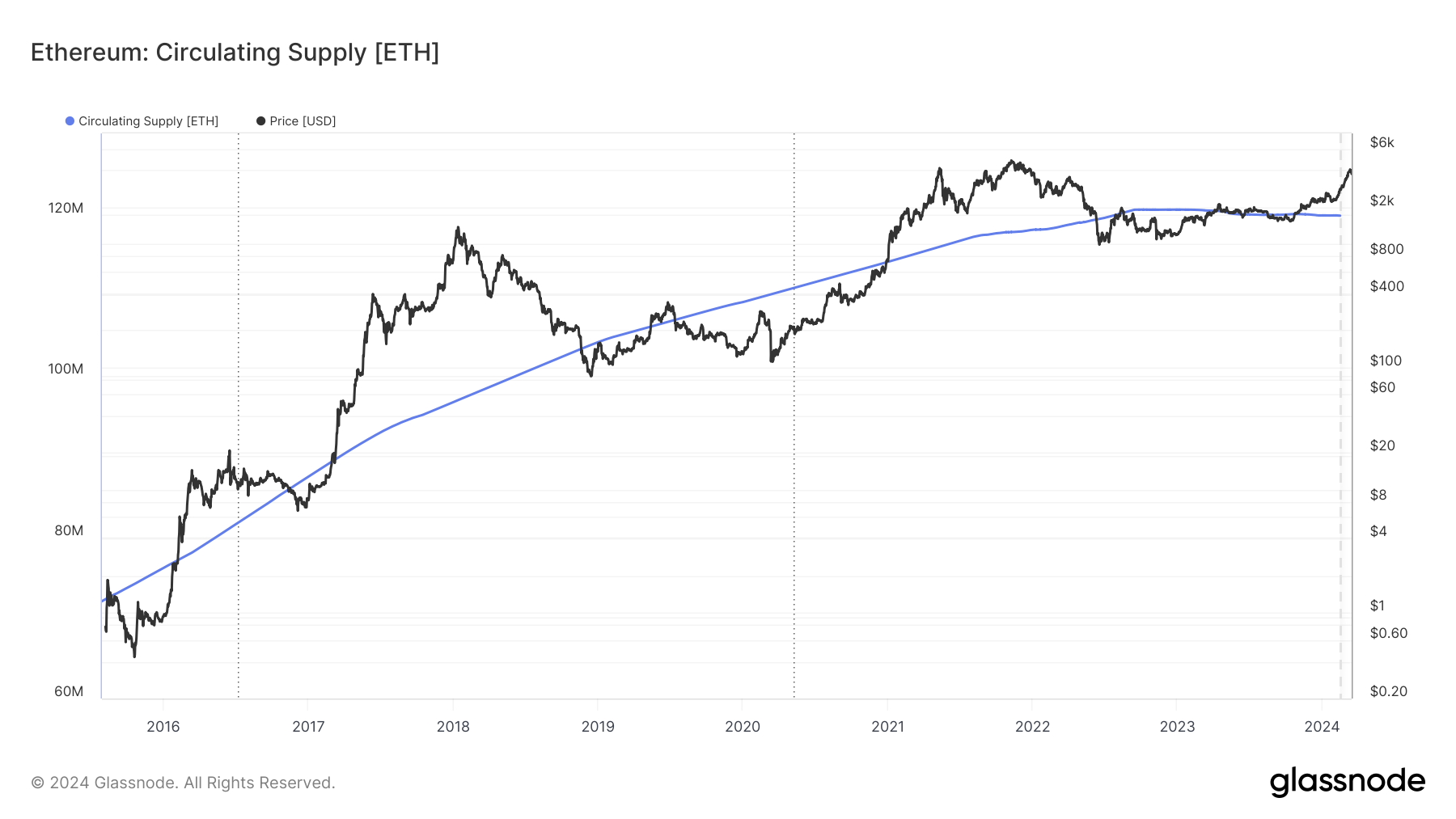Issue 9: Ethereum's big week
In this issue, we look at Ethereum three ways including ETH supply dynamics, the recent network upgrades, and the importance of the continued execution of Ethereum's roadmap.

Ethereum, the number two cryptocurrency by market cap, just wrapped a big week. The headline news is that the Ethereum community completed a massive system update, called Dencun.
We’ll jump into why the upgrade is so timely in a minute.
But the other major takeaway from this week is that the upgrade demonstrates the significance of Ethereum's roadmap. The ability to regularly achieve milestones that have positive impacts on the tech stack and the wider constellation of apps and services using Ethereum is impressive.
Lastly, the price of Ethereum was hovering around $4k earlier in the week, a price not seen since 2021. While it is always hard to separate Ethereum’s price from the activities of the broader crypto market — ETH generally remains correlated to BTC — there are some notable happenings, which is where we’ll start this week’s update.
The changing dynamics of Ethereum’s price
Just a quick reminder: Nobody knows where the price of ETH is going this week, this month, or this year. My take is that you should be very skeptical of talking heads who throw out arbitrary price targets.
What follows isn’t financial advice. Instead, it’s just a look at developing price dynamics — especially during this time of major market movements.
The biggest of these dynamics is Ethereum’s supply. Since the last big upgrade (the Merge, which launched in late 2021), Ethereum’s overall supply has plateaued and is now dropping slightly.

It’s important to take note of the supply situation for two reasons:
- One, basic economics tells us that the relationship of supply and demand is important. If supply goes down and demand goes up, then the price will go up.
- Two, the recent Dencun upgrade makes it easier and cheaper to build more apps and services on Ethereum via rollups and other layer twos. The likely result is that more people will use the network, the demand for block space will grow and the supply will continue to be constricted, which again leads us back to fundamental economics.
However, any ideas of runaway Ethereum prices should be tempered by the reality of current market behavior. The entire crypto market is surging because of the consistent inflows into the newly launched Bitcoin ETFs.
This is a major change to the way that capital enters the crypto market — and it will likely have an impact on the way that assets like Bitcoin and Ethereum behave relative to one another. At the same time, an Ethereum ETF is still awaiting SEC approval, with a decision likely coming in May (although there are mixed opinions on whether the approval will actually happen).
Why DenCun and EIP 4844 are a big deal
One of the biggest drawbacks for people moving more and more of their digital lives onchain is that transactions are expensive relative to more traditional ways of doing things.
The fees to use blockchain exist because they pay for the overall security and operations of the underlying protocol and network. Transactions require handling data, and handling data in a decentralized computing environment comes at a cost.
The user fees for a blockchain network are like paying user fees to use a public park. For the purpose of our analogy, what we have now in web2 are corporate parks with manicured lawns and nice facilities. The parks are free (we pay with by suppling really personal information about our lives instead) but have limited access: you can only visit at certain times and you're not allowed to get out of your car. Leaving the main trails or attractions is strictly prohibited.
On the other hand, a park managed by blockchain has no rules. You can go do whatever you want, wherever you want. The only issue is that some people abuse the lack of rules (security threats) and some people need to get rescued in the backcountry (data availability costs). The result is that the cost of visiting this new kind of park is greater than visiting a corporate park. The biggest advantage is that there aren't any hidden fees like paying with our data.
This gets us back to the recent Dencun upgrade, which is designed to drive down user fees.
The upgrade consists of several Ethereum Improvement Proposals (EIPs) that are specific projects proposed and approved by the Ethereum developer community to enhance overall infrastructure. EIP 4844 is a major one.

Check out this post to dive deeper into blobs and learn about the other impacts of EIP 4844
EIP 4844 introduces a new way of handling data on Ethereum called blobs. Put simply, blobs make it possible to separate and handle data so that only the essential components of a transaction get written and recorded to a blockchain, this reduces costs and congestion.
The update makes it easier for other projects to build new transaction functionality that will make handling day-to-day stuff onchain easier and more competitive with using more traditional services.
Revisiting our park user fee analogy, EIP 4844 essentially creates a way to visit the park for a picnic or a quick sightseeing trip without having to pay for backcountry rescue insurance or deal with other security fees.
Since most park visitors aren’t interested in extreme travel or aren’t going to break the rules, adding a cheaper and more lightweight day-use-style pass option makes sense. The result will be more visitors to the park without needing to compromise on the overall user experience. In other words, it makes the park more accessible.
The bigger picture: Ethereum’s roadmap
The Dencun upgrade was just the latest piece of an ambitious plan to continually upgrade Ethereum to optimize cost, speed, consensus, decentralization, and overall experience.
I wrote more about some of the specifics of the roadmap, which I’ll link below in case you are interested.

Get more details on the Ethereum's roadmap
The big picture takeaway is that the coordinated execution of a long-term plan by a distributed and independent group of developers shipping technical upgrades is larger than just building a better blockchain network.
The continual and successful execution of Ethereum’s roadmap is also a proving ground for a new way for people and groups to organize and coordinate on the internet. During a time when it feels like legacy institutions and groups are not working anymore — or a time when the inefficiencies of massive bureaucracies feel dangerously antiquated, having a model to move forward and leverage time, talent, and financial resources in a way that results in forward progress feels promising.
In some ways, the Ethereum price, upgrades, and roadmap themes all braid together. It’s a major success story for decentralized technology that the Ethereum community can continually upgrade its infrastructure.
It’s hard to imagine how these upgrades don’t help onboard more people to crypto, especially as more easy-to-use apps and services start launching onchain. And that brings us back to where we started.
Until next week,